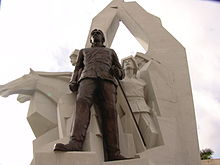Ignacio Agramonte
| Ignacio Agramonte | |
|---|---|

Statue of Ignacio Agramonte on the Plaza de Revolución in Camagüey
|
|
| Born | December 23, 1841 Puerto Príncipe (now Camagüey), (Cuba) |
| Died | May 11, 1873 Jimaguayú, Cuba |
Ignacio Agramonte y Loynáz (1841—1873) was a Cuban revolutionary, who played an important part in the Ten Years' War (1868–1878).
Born in the province of Puerto Príncipe (what is now the province of Camagüey, Cuba) on December 23, 1841, to a wealthy family. He went to Barcelona, Madrid, and Havana to study law. On June 11, 1865 he graduated as a lawyer.
He returned to Puerto Principe and married Amalia Simoni y Argilagos in August 1868, a woman who was the love of his life and whose family had considerably more wealth than his own.
Agramonte stood tall at 6'2". He had fine brown hair, pale skin, and was an expert horseman and fencer. He had a fine mustache and not thick or bushy like it appears in many portraits.
When the war of independence against the Spanish broke out in October 10, 1868, he played a pivotal role in the uprising of the province of Camagüey which took place on November 4, 1868. Agramonte himself joined the war a week later, on November 11, 1868.
His wife followed him in the struggle, but was captured on May 26, 1870 while pregnant with her second child, who was born in the USA and never met his father.
At a conference with other leaders who were trying to make amends with Spain, Agramonte made clear his opinion: "Stop at once all the lobbying, the awkward delays, and the humiliating demands: Cuba's only option is to gain its redemption by tearing itself from Spain through armed force."
In February 1869, he and Antonio Zambrana were elected secretaries, a title equivalent to minister, to the provincial government. He was subsequently elected a member and one of two secretaries - minister - of the Cuban Congress in Arms. He was among the signatories of the act that freed the slaves on the island and was the driving force in the drafting of the first Constitution in Cuban history.
He resigned his secretarial and ministerial position within the Congress after Carlos Manuel de Céspedes was made president that same year because Agramonte had strong political disagreements with him and knew they could not work together. The Congressional secretaries - ministers - had to work closely with the president.
He went on to become Major General of the Cuban forces for the military district of the province of Camagüey, where he organized the best cavalry troops in the Cuban Liberation Army. Showing great vision, in spite of his lack of formal military training, his troops terrified the Spanish Army. The Spaniards knew him to be formidable in battle, and nicknamed him "The Young Bolívar".
...
Wikipedia
